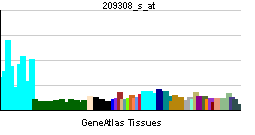BCL2/adenovirus E1B 19 kDa protein-interacting protein 2 is a protein that in humans is encoded by the BNIP2 gene.[1][2]
This gene is a member of the BCL2/adenovirus E1B 19 kd-interacting protein (BNIP) family. Though the specific function is unknown, it interacts with the E1B 19 kDa protein which is responsible for the protection of virally-induced cell death, as well as E1B 19 kDa-like sequences of BCL-2, also an apoptotic protector.[2]
Interactions [link]
BNIP2 has been shown to interact with CDC42,[3][4][5] ARHGAP1[4][5] and Bcl-2.[1][6]
References [link]
- ^ a b Boyd JM, Malstrom S, Subramanian T, Venkatesh LK, Schaeper U, Elangovan B, D'Sa-Eipper C, Chinnadurai G (November 1994). "Adenovirus E1B 19 kDa and Bcl-2 proteins interact with a common set of cellular proteins". Cell 79 (2): 341–51. DOI:10.1016/0092-8674(94)90202-X. PMID 7954800.
- ^ a b "Entrez Gene: BNIP2 BCL2/adenovirus E1B 19kDa interacting protein 2". https://www.ncbi.nlm.nih.gov/sites/entrez?Db=gene&Cmd=ShowDetailView&TermToSearch=663.
- ^ Low, B C; Seow K T, Guy G R (May. 2000). "Evidence for a novel Cdc42GAP domain at the carboxyl terminus of BNIP-2". J. Biol. Chem. (UNITED STATES) 275 (19): 14415–22. DOI:10.1074/jbc.275.19.14415. ISSN 0021-9258. PMID 10799524.
- ^ a b Low, B C; Seow K T, Guy G R (December 2000). "The BNIP-2 and Cdc42GAP homology domain of BNIP-2 mediates its homophilic association and heterophilic interaction with Cdc42GAP". J. Biol. Chem. (UNITED STATES) 275 (48): 37742–51. DOI:10.1074/jbc.M004897200. ISSN 0021-9258. PMID 10954711.
- ^ a b Low, B C; Lim Y P, Lim J, Wong E S, Guy G R (November 1999). "Tyrosine phosphorylation of the Bcl-2-associated protein BNIP-2 by fibroblast growth factor receptor-1 prevents its binding to Cdc42GAP and Cdc42". J. Biol. Chem. (UNITED STATES) 274 (46): 33123–30. DOI:10.1074/jbc.274.46.33123. ISSN 0021-9258. PMID 10551883.
- ^ Qin, Wenxin; Hu Jian, Guo Minglei, Xu Jian, Li Jinjun, Yao Genfu, Zhou Xiaomei, Jiang Huiqiu, Zhang Pingping, Shen Li, Wan Dafang, Gu Jianren (August 2003). "BNIPL-2, a novel homologue of BNIP-2, interacts with Bcl-2 and Cdc42GAP in apoptosis". Biochem. Biophys. Res. Commun. (United States) 308 (2): 379–85. DOI:10.1016/S0006-291X(03)01387-1. ISSN 0006-291X. PMID 12901880.
Further reading [link]
- Belcredito S, Vegeto E, Brusadelli A, et al. (2002). "Estrogen neuroprotection: the involvement of the Bcl-2 binding protein BNIP2". Brain Res. Brain Res. Rev. 37 (1–3): 335–42. DOI:10.1016/S0165-0173(01)00138-2. PMID 11744098.
- Ohi N, Tokunaga A, Tsunoda H, et al. (1999). "A novel adenovirus E1B19K-binding protein B5 inhibits apoptosis induced by Nip3 by forming a heterodimer through the C-terminal hydrophobic region". Cell Death Differ. 6 (4): 314–25. DOI:10.1038/sj.cdd.4400493. PMID 10381623.
- Low BC, Lim YP, Lim J, et al. (2000). "Tyrosine phosphorylation of the Bcl-2-associated protein BNIP-2 by fibroblast growth factor receptor-1 prevents its binding to Cdc42GAP and Cdc42". J. Biol. Chem. 274 (46): 33123–30. DOI:10.1074/jbc.274.46.33123. PMID 10551883.
- Low BC, Seow KT, Guy GR (2000). "Evidence for a novel Cdc42GAP domain at the carboxyl terminus of BNIP-2". J. Biol. Chem. 275 (19): 14415–22. DOI:10.1074/jbc.275.19.14415. PMID 10799524.
- Low BC, Seow KT, Guy GR (2001). "The BNIP-2 and Cdc42GAP homology domain of BNIP-2 mediates its homophilic association and heterophilic interaction with Cdc42GAP". J. Biol. Chem. 275 (48): 37742–51. DOI:10.1074/jbc.M004897200. PMID 10954711.
- Zhou YT, Soh UJ, Shang X, et al. (2002). "The BNIP-2 and Cdc42GAP homology/Sec14p-like domain of BNIP-Salpha is a novel apoptosis-inducing sequence". J. Biol. Chem. 277 (9): 7483–92. DOI:10.1074/jbc.M109459200. PMID 11741952.
- Strausberg RL, Feingold EA, Grouse LH, et al. (2003). "Generation and initial analysis of more than 15,000 full-length human and mouse cDNA sequences". Proc. Natl. Acad. Sci. U.S.A. 99 (26): 16899–903. DOI:10.1073/pnas.242603899. PMC 139241. PMID 12477932. //www.pubmedcentral.nih.gov/articlerender.fcgi?tool=pmcentrez&artid=139241.
- Qin W, Hu J, Guo M, et al. (2003). "BNIPL-2, a novel homologue of BNIP-2, interacts with Bcl-2 and Cdc42GAP in apoptosis". Biochem. Biophys. Res. Commun. 308 (2): 379–85. DOI:10.1016/S0006-291X(03)01387-1. PMID 12901880.
- Shang X, Zhou YT, Low BC (2003). "Concerted regulation of cell dynamics by BNIP-2 and Cdc42GAP homology/Sec14p-like, proline-rich, and GTPase-activating protein domains of a novel Rho GTPase-activating protein, BPGAP1". J. Biol. Chem. 278 (46): 45903–14. DOI:10.1074/jbc.M304514200. PMID 12944407.
- Gerhard DS, Wagner L, Feingold EA, et al. (2004). "The status, quality, and expansion of the NIH full-length cDNA project: the Mammalian Gene Collection (MGC)". Genome Res. 14 (10B): 2121–7. DOI:10.1101/gr.2596504. PMC 528928. PMID 15489334. //www.pubmedcentral.nih.gov/articlerender.fcgi?tool=pmcentrez&artid=528928.
- Zhou YT, Guy GR, Low BC (2005). "BNIP-2 induces cell elongation and membrane protrusions by interacting with Cdc42 via a unique Cdc42-binding motif within its BNIP-2 and Cdc42GAP homology domain". Exp. Cell Res. 303 (2): 263–74. DOI:10.1016/j.yexcr.2004.08.044. PMID 15652341.
- Rual JF, Venkatesan K, Hao T, et al. (2005). "Towards a proteome-scale map of the human protein-protein interaction network". Nature 437 (7062): 1173–8. DOI:10.1038/nature04209. PMID 16189514.
| This article on a gene on chromosome 15 is a stub. You can help Wikipedia by expanding it. |
https://wn.com/BNIP2
Podcasts:
PLAYLIST TIME:


